class: center, middle, inverse, title-slide .title[ # The topological shape of plants ] .subtitle[ ## A <strong>handwavy</strong> introduction to Topological Data Analysis ] .author[ ### <strong>Erik Amézquita</strong> <br> — <br> Computational Mathematics, Science, and Engineering <br> Michigan State University <br> — ] .date[ ### 2023-03-19 ] --- background-image: url("../../img/endlessforms.png") background-size: 150px background-position: 89% 7% class: inverse # Plant morphology <div class="row"> <div class="column" style="max-width:50%"> <iframe width="375" height="210" src="https://www.youtube-nocookie.com/embed/oM9kAq0PBvw?controls=0" frameborder="0" allow="accelerometer; autoplay; encrypted-media; gyroscope; picture-in-picture" allowfullscreen></iframe> <iframe width="375" height="210" src="https://www.youtube-nocookie.com/embed/V39K58evWlU?controls=0" frameborder="0" allow="accelerometer; autoplay; encrypted-media; gyroscope; picture-in-picture" allowfullscreen></iframe> </div> <div class="column" style="max-width:50%"> <iframe width="375" height="210" src="https://www.youtube-nocookie.com/embed/efF5PSvFQ2A?controls=0" frameborder="0" allow="accelerometer; autoplay; encrypted-media; gyroscope; picture-in-picture" allowfullscreen></iframe> <iframe width="375" height="210" src="https://www.youtube-nocookie.com/embed/qkOjHHuoUhA?controls=0" frameborder="0" allow="accelerometer; autoplay; encrypted-media; gyroscope; picture-in-picture" allowfullscreen></iframe> </div> </div> <p style="font-size: 24px; text-align: right; font-family: 'Yanone Kaffeesatz'">Check out more 3D X-ray CT scans at <a href="https://www.youtube.com/@endlessforms6756">youtube.com/@endlessforms6756</a></p> --- # Topological Data Analysis (TDA) <div class="row" style="font-family: 'Yanone Kaffeesatz'"> <div class="column" style="max-width:25%; font-size: 20px;"> <img style="padding: 25px 0 35px 0;" src="../figs/S019_L0_1.gif"> <p style="font-size: 30px; text-align: center; color: DarkRed;"> Raw Data </p> <ul> <li> X-ray CT </li> <li> Point clouds </li> <li> Time series </li> <ul> </div> <div class="column" style="max-width:40%; padding: 0 25px 0 25px; font-size: 20px;"> <img src="../figs/ecc_X.gif"> <p style="font-size: 28px; text-align: center; color: DarkRed;"> Topological Summary </p> <ul> <li> Euler Characteristic </li> <li> Persistence diagrams </li> <li> Mapper/Reeb graphs </li> <ul> </div> <div class="column" style="max-width:35%; font-size: 20px;"> <img src="../figs/svm_mds_ect.gif"> <p style="font-size: 30px; text-align: center; color: DarkRed;"> Analysis </p> <ul> <li> Statistics </li> <li> Machine learning </li> <li> Classification/prediction </li> <ul> </div> </div> --- background-image: url("../../img/cmse_logo.svg") background-size: 150px background-position: 1% 50% class: center # My research: Crossing and merging bridges <div class="row"> <div class="column" style="width:15%"> </div> <div class="column" style="max-width:15%"> <a href="https://doi.org/10.1093/insilicoplants/diab033" target="_blank"><img style="padding: 0 0 0 0;" src="../figs/S017_L3_1.gif"></a> </div> <div class="column" style="max-width:18%"> <a href="https://doi.org/10.1002/ppp3.10333" target="_blank"><img style="padding: 0 0 0 0;" src="../../citrus/figs/SR01_L01_black_exocarp.gif"></a> </div> <div class="column" style="max-width:25%"> <img style="padding: 0 0 0 0;" src="../../arabidopsis/figs/Day7_110921_U112-3_pot0_leaf_X.gif"> </div> <div class="column" style="max-width:25%"> <img style="padding: 0 0 0 0;" src="../../walnuts/figs/2014SBa_R5_T81_meat_2.gif"> </div> </div> <div class="row"> <div class="column" style="width:15%"> <p style="font-size:5px">—</p> </div> <div class="column" style="max-width:28%"> <a href="https://plantsandpython.github.io/PlantsAndPython/00_Opening_page.html" target="_blank"><img style="padding: 0 0 0 0;" src="../../tutorials/figs/plants_and_python_group_photo.jpg"></a> </div> <div class="column" style="max-width:50%"> <a href="https://doi.org/10.1073/pnas.2217564120" target="_blank"><img style="padding: 0 0 0 0;" src="../../journal_diversity/figs/frequencies_globe_inv.jpg"></a> </div> </div> <div class="list" style="font-size: 10px; text-align: left;"> <ul> <li>Marks <em>et al.</em> (2023) A critical analysis of plant science literature reveals ongoing inequities. DOI: <a href="https://doi.org/10.1073/pnas.2217564120" target="_blank">10.1101/2022.10.15.512190</a></li> <li><strong>A</strong> <em>et al.</em> (2022) The shape of aroma: measuring and modeling citrus oil gland distribution. DOI: <a href="https://doi.org/10.1002/ppp3.10333" target="_blank">10.1002/ppp3.10333</a></li> <li><strong>A</strong> <em>et al.</em> (2022) Genomics data analysis via spectral shape and topology. DOI: <a href="https://doi.org/10.48550/arXiv.2211.00938" target="_blank">10.48550/arXiv.2211.00938</a></li> <li>VanBuren<em>et al.</em> (2022) Teaching tools in plant biology. Plants and Python, coding from scratch in the plant sciences. DOI: <a href="https://doi.org/10.1093/plcell/koac187" target="_blank">10.1093/plcell/koac187</a>.</li> <li><strong>A</strong> <em>et al.</em> (2021) Measuring hidden phenotype: Quantifying the shape of barley seeds using the Euler Characteristic Transform. DOI: <a href="https://doi.org/10.1093/insilicoplants/diab033" target="_blank">10.1093/insilicoplants/diab033</a></li> <li><strong>A</strong> <em>et al.</em> (2020) The shape of things to come: Topological data analysis and biology, from molecules to organisms. DOI: <a href="https://doi.org/10.1002/dvdy.175" target="_blank">10.1002/dvdy.175</a></li> </ul> </div> --- # The shape of things to come <div class="row" style="font-family: 'Yanone Kaffeesatz'; font-size:22px;"> <div class="column" style="max-width:33%"> <p style="line-height:0;font-size:28px;text-align: center;">The shape of data</p> <img style="padding: 0 22px;" src="https://raw.githubusercontent.com/sperciva/Backups/main/Tutorial/animation.gif"></img> <img style="padding: 0 10px;" src="https://raw.githubusercontent.com/sperciva/Backups/main/Tutorial/animation_diagram.gif"></img> <p style="text-align: center;">Ultra quick introduction</p> <p style="text-align: center;">TDA + Biology in literature</p> </div> <div class="column" style="max-width:33%"> <p style="line-height:0;font-size:28px;text-align: center;">The shape of development</p> <img style="padding: 0 60px;" src="../../citrus/figs/SR01_L01_black_exocarp.gif"></img> <img style="padding: 0 26px;" src="../../citrus/figs/SW03_CRC1241-B_12B-4-3_L00_lambproj_v.jpg"></img> <p style="text-align: center;">Oil gland distributions</p> <p style="text-align: center;">Persistent Homology</p> </div> <div class="column" style="max-width:33%"> <p style="line-height:0;text-align: center; font-size:28px">The shape of adaptability</p> <img style="padding: 0 70px;" src="../figs/S017_L3_1.gif"></img> <img style="padding: 0 55px;" src="../figs/ecc_X.gif"></img> <p style="text-align: center;">Seed phenotyping</p> <p style="text-align: center;">Euler Characteristic Transform</p> </div> </div> --- class: inverse, middle, center # 1. Shape is data and data is shape ## TDA meets biology in a number of ways ### The significance of detecting connected components and holes --- # 1st TDA Ingredient: Complexes - Think the data as a collection of elementary building blocks ( _cells_ ) Vertices | Edges | Faces | Cubes ---------|-------|-------|------- 0-dim | 1-dim | 2-dim | 3-dim - A collection of cells is a _cubical complex_ - Count the number of topological features ( _holes_ ): Connected components | Loops | Voids ---------------------|-------|------- 0-dim | 1-dim | 2-dim - Example with 2 connected components, 1 loop, 0 voids <img src="../../tda/figs/binary_to_cubical_complex_textless.svg" width="500" style="display: block; margin: auto;" /> --- # 2nd TDA Ingredient: Filters - Each cell is assigned a real value which defines how the complex is constructed. - Observe how the number of topological features change as the complex grows. .pull-left[ <img src="../figs/eigcurv_filter.gif" width="250px" style="display: block; margin: auto;" /><img src="../figs/gaussian_density_filter.gif" width="250px" style="display: block; margin: auto;" /> ] .pull-right[ <img src="../figs/eccentricity_filter.gif" width="250px" style="display: block; margin: auto;" /><img src="../figs/vrips_ver2.gif" width="250px" style="display: block; margin: auto;" /> ] --- # TDA + Biology in the literature <div class="row"> <div class="column" style="max-width:25%"> <img style="padding: 0 0 0 0;" src="https://ars.els-cdn.com/content/image/1-s2.0-S1361841518302688-gr1.jpg"> <img style="padding: 0 0 0 0;" src="https://ars.els-cdn.com/content/image/1-s2.0-S1361841518302688-gr2.jpg"> <p style="font-size: 10px; text-align: right; color: Grey;"> Credits: <a href="https://doi.org/10.1016/j.media.2019.03.014">Qaiser <em>et al.</em> (2019)</a></p> </div> <div class="column" style="max-width:25%"> <img style="padding: 0 0 0 0;" src="https://www.pnas.org/cms/10.1073/pnas.1313480110/asset/ce30e9df-d595-4520-a68a-74f3c6f151d1/assets/graphic/pnas.1313480110fig01.jpeg"> <img style="padding: 0 0 0 0;" src="https://www.pnas.org/cms/10.1073/pnas.1313480110/asset/b733c3a3-00f2-43d5-b372-9da25f3d33c9/assets/graphic/pnas.1313480110fig02.jpeg"> <p style="font-size: 10px; text-align: right; color: Grey;"> Credits: <a href="https://doi.org/10.1073/pnas.1313480110">Chan <em>et al.</em> (2013)</a></p> </div> <div class="column" style="max-width:22%"> <img style="padding: 0 0 0 0;" src="https://www.degruyter.com/document/doi/10.1515/sagmb-2015-0057/asset/graphic/j_sagmb-2015-0057_fig_001.jpg"> <img style="padding: 0 0 0 0;" src="https://www.degruyter.com/document/doi/10.1515/sagmb-2015-0057/asset/graphic/j_sagmb-2015-0057_fig_012.jpg"> <img style="padding: 0 0 0 0;" src="https://www.degruyter.com/document/doi/10.1515/sagmb-2015-0057/asset/graphic/j_sagmb-2015-0057_fig_010.jpg"> <p style="font-size: 10px; text-align: right; color: Grey;"> Credits: <a href="https://doi.org/10.1515/sagmb-2015-0057">Kovacev-Nikolic <em>et al.</em> (2016)</a></p> </div> <div class="column" style="max-width:28%"> <img style="padding: 0 0 0 0;" src="https://media.springernature.com/original/springer-static/image/chp%3A10.1007%2F978-3-030-20867-7_7/MediaObjects/484957_1_En_7_Fig1_HTML.png"> <p style="font-size: 10px; text-align: right; color: Grey;"> Credits: <a href="https://doi.org/10.1007/978-3-030-20867-7_7">Chitwood <em>et al.</em> (2019)</a></p> </div> </div> <div class="row" style="font-family: 'Yanone Kaffeesatz'; font-size:25px;"> <div class="column" style="width:25%;"> <p style="text-align: center;">Holes</p> <p style="text-align: center;">↓</p> <p style="text-align: center;">Cancerous tissue</p> </div> <div class="column" style="width:25%;"> <p style="text-align: center;">Holes</p> <p style="text-align: center;">↓</p> <p style="text-align: center;">Horizontal Reassortment</p> </div> <div class="column" style="width:25%;"> <p style="text-align: center;">Holes</p> <p style="text-align: center;">↓</p> <p style="text-align: center;">Open/closed conformations</p> </div> <div class="column" style="width:25%;"> <p style="text-align: center;">Components</p> <p style="text-align: center;">↓</p> <p style="text-align: center;">Panicle structure</p> </div> </div> --- ## Persistent Homology: the Vietoris-Rips Complex .pull-left[ Given: - Point cloud `\(X\)` - Distance `\(r\)` The Vietoris-Rips complex, `\(VR(X, r)\)`, is a simplicial complex where: - If `\(n\)` points have pairwise distances `\(\leq r\)` , then the `\(n − 1\)` simplex formed by those points is added. ] .pull-right[ 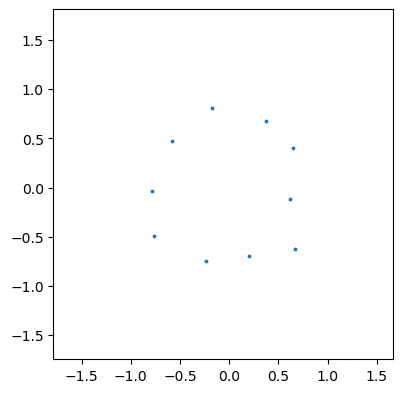 <p style="font-size: 10px; text-align: right; color: Grey; line-height:0; margins:0;padding:0;"> Credits: Sarah Percival</p> ] --- ## Persistent Homology: Persistence Diagrams 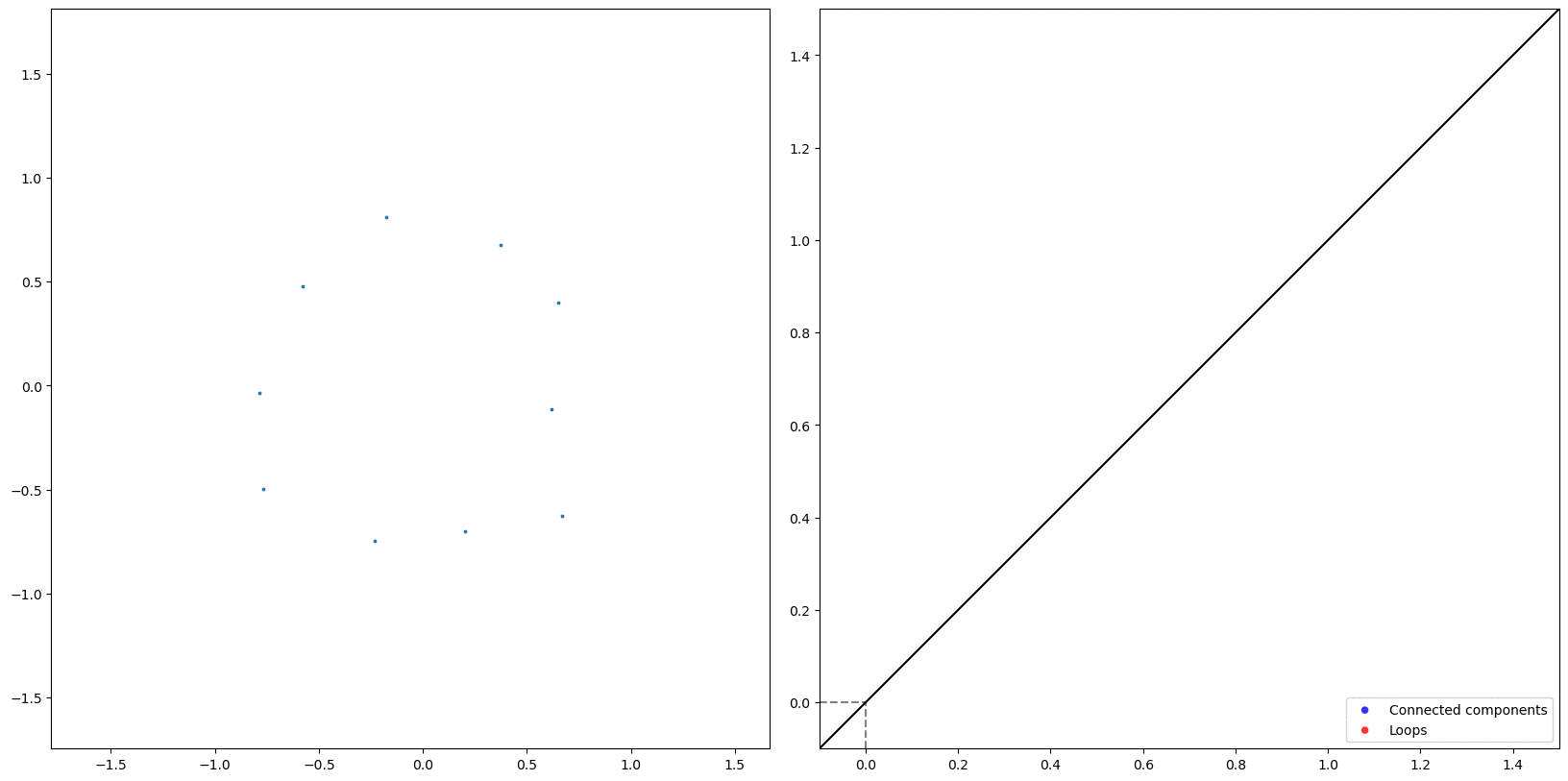 <p style="font-size: 10px; text-align: right; color: Grey; line-height:0; margins:0;padding:0;"> Credits: Sarah Percival</p> - Keep track of the birth and death of topological features in a death-vs-birth time diagram - Handwavily: it is the multiset `\(\text{dgm} = \bigcup_{d\geq0}\{(\text{birth},\,\text{death})_d\}\cup\text{diagonal}.\)` --- ## Compare PDs via the Bottleneck distance  Given two persistence diagrams `\(\text{dgm}_1\)` and `\(\text{dgm}_2\)`, consider `\(\Gamma\)` the set of all bijections between these two multisets and `$$d_B(\text{dgm}(X),\text{dgm}(Y)) = \inf_{\gamma\in\Gamma}\sup_{p\in\text{dgm}(X)}\| p - \gamma(p)\|_\infty$$` --- ## The motivation - TL;DR: If the original point cloud wiggles a tiny bit, then the elements of its Vietoris-Rips-related persistence diagram will wiggle only a tiny bit as well. <hr> - **Theorem (Chazal, de Silva, Oudot, 2013)**: The bottleneck distance is stable with respect to the Gromov-Hausdorff distance. For `\(X\)` and `\(Y\)` totally bounded metric spaces, `$$d_B(\text{dgm}(X),\text{dgm}(Y)) \leq 2d_{GH}(X, Y).$$` Where `\(d_{GH}\)` is the Gromov-Hausdorff distance. - The GH distance is a generalization of the Hausdorff distance: If `\(X\)`, `\(Y\)` are two subsets of the same metric space, then `$$d_H(X,Y) = \inf\{\varepsilon > 0 | X\subset Y^\varepsilon, \; Y\subset X^\varepsilon\}$$` - If `\(X\)`, `\(Y\)` are any two spaces, then `$$d_{GH}(X,Y) = \inf_{\text{isometric embeddings}\;X\hookrightarrow Z,\:Y\hookrightarrow Z}\{d_H^Z(X,Y)\}$$` --- # Topology: The Euler characteristic `$$\begin{align} \chi &= \#(\text{Vertices}) - \#(\text{Edges}) + \#(\text{Faces}) \\ &= \#(\text{Connected Components}) - \#(\text{Loops}) + \#(\text{Voids}). \end{align}$$` <div class="row"> <div class="column" style="width:5%"> </div> <div class="column" style="max-width:30%"> <img style="padding: 0 0 0 0;" src="../../tda/figs/tetrahedron.gif"> </div> <div class="column" style="max-width:30%"> <img style="padding: 0 0 0 0;" src="../../tda/figs/cube.gif"> </div> <div class="column" style="max-width:30%"> <img style="padding: 0 0 0 0;" src="../../tda/figs/octahedron.gif"> </div> <div class="column" style="width:5%"> </div> </div> <div class="row"> <div class="column" style="width:5%"> </div> <div class="column" style="max-width:30%"> <img style="padding: 0 0 0 0;" src="../../tda/figs/dodecahedron.gif"> </div> <div class="column" style="max-width:30%"> <img style="padding: 0 0 0 0;" src="../../tda/figs/icosahedron.gif"> </div> <div class="column" style="max-width:30%"> <p style="padding: 50px 0 0 10px; font-size: 48px; text-align: center; color: #18453B; line-height: 1.25; font-family: 'Yanone Kaffeesatz';"> V - E + F = 2</p> </div> <div class="column" style="width:5%"> </div> </div> --- background-image: url("../figs/ecc_ver2.gif") background-size: 750px background-position: 50% 90% # Euler Characteristic Curve (ECC) - Consider a cubical complex `\(X\subset\mathbb{R}^d\)` - And a unit-length direction `\(\nu\in S^{d-1}\)` - And the subcomplex containing all cubical cells below height `\(h\)` in the direction `\(\nu\)` `$$X(\nu)_h =\{\Delta \in X\::\:\langle x,\nu\rangle\leq h\text{ for all }x\in\Delta\}$$` - The Euler Characteristic Curve (ECC) of direction `\(\nu\)` is defined as the sequence `$$\{\chi(X(\nu)_h)\}_{h\in\mathbb{R}}$$` --- background-image: url("../figs/ect_ver2.gif") background-size: 800px background-position: 50% 88% ## Euler Characteristic Transform (ECT) - Repeat and concatenate for all possible directions. $$ `\begin{split} ECT(X):\; & S^{d-1} \to \mathbb{Z}^{\mathbb{R}}\\ &\nu\mapsto\{\chi(X(\nu)_h)\}_{h\in\mathbb{R}}. \end{split}` $$ - [**Theorem** (Turner, Mukherjee, Boyer 2014) & (Curry, Mukherjee, Turner, 2018)](http://arxiv.org/abs/1805.09782): The ECT is injective with a finite bound of necessary directions. --- background-image: url("../figs/turner_etal_2014.png") background-size: 280px background-position: 99% 1% # The motivation - Easy to compute: a quick alternating sum. - *Different* simplicial complexes correspond to *different* ECTs. - [**Theorem _(ibid)_**](https://arxiv.org/abs/1310.1030): The ECT effectively summarizes all possible information related to shape. There is elusive math research on computationally efficient reconstruction algorithms: - [Turner, Mukherjee, Curry (2021)](https://arxiv.org/abs/1805.09782): Finite number of directions - [Betthauser (2018)](https://people.clas.ufl.edu/peterbubenik/files/Betthauser_Thesis.pdf): 2D reconstruction - [Fasy, Micka, Millman, Schenfisch, Williams (2022)](https://arxiv.org/abs/1912.12759): 3D reconstruction - [Crawford, Monod, Chen, Mukherjee, Rabadan (2020)](https://doi.org/10.1080/01621459.2019.1671198): Smooth ECT - [Jiang, Kurtek, Needham (2020)](https://openaccess.thecvf.com/content_CVPRW_2020/papers/w50/Jiang_The_Weighted_Euler_Curve_Transform_for_Shape_and_Image_Analysis_CVPRW_2020_paper.pdf): Weighted ECT <img src="../../arabidopsis/figs/ect_col-0_pot0_leaf0.gif" width="500px" style="display: block; margin: auto;" /> --- # Shameless plug - [Review paper](https://doi.org/10.1002/dvdy.175) with more content, references, and examples <img src="../../tda/figs/amezquita_etal_2020.png" width="550px" style="display: block; margin: auto;" /> - [Jupyter notebook](https://github.com/amezqui3/demeter/blob/main/tutorial/nappn2022_shape_of_things_to_come.ipynb) with even more links and resources: `bit.ly/nappn22` <img src="../figs/github_demeter.png" width="250px" style="display: block; margin: auto;" /> - This slides: `bit.ly/ustars23` --- class: center, inverse, middle # 2. If life gives you lemons... ## Modeling citrus oil gland distribution ### Comparing limes to oranges with directional statistics --- ## Think of citrus as lego blocks 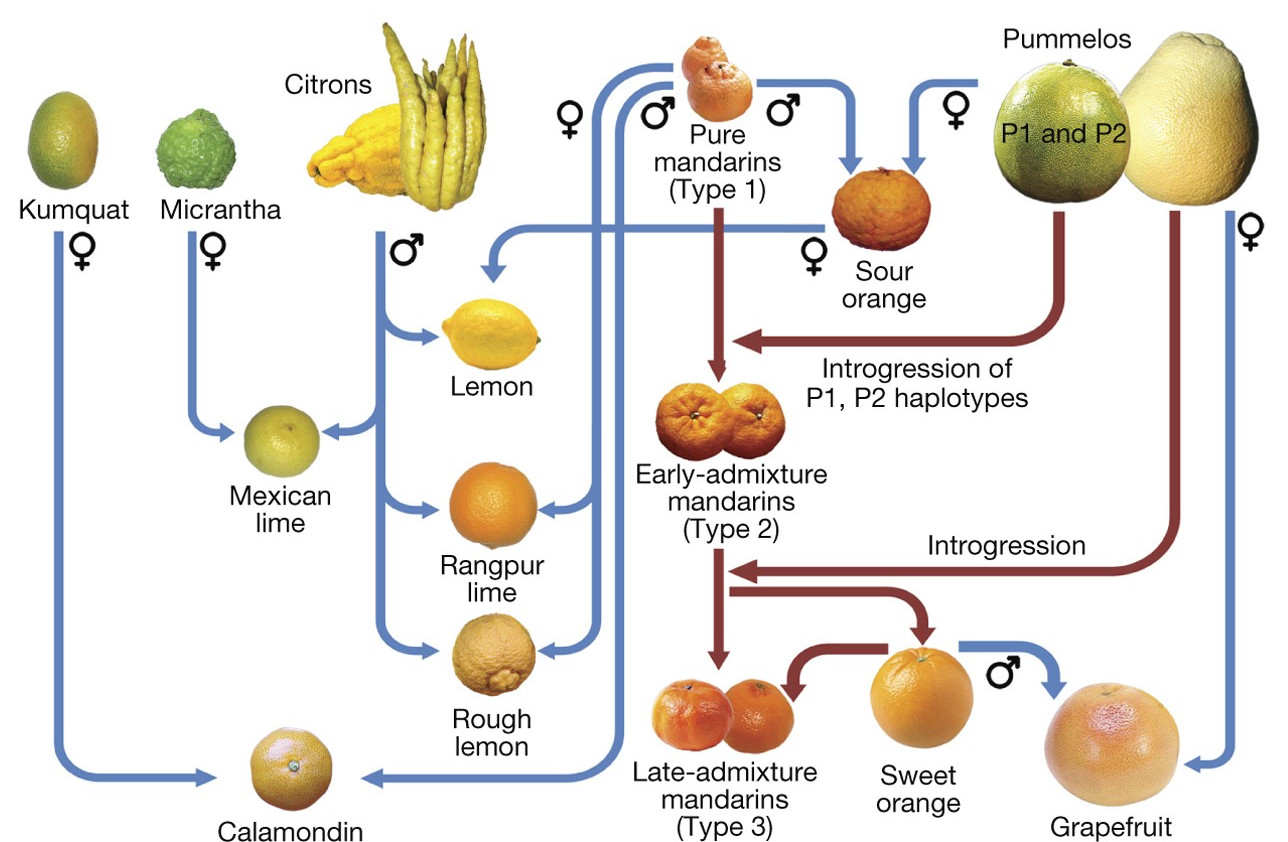 <p style="font-size: 10px; text-align: right; color: Grey;"> Credits: <a href="https://doi.org/10.1038/nature25447">Wu <em>et al.</em> (2018)</a></p> --- ## X-rays → Image Processing → Oil glands <div class="row"> <div class="column" style="max-width:37%; color: Navy; font-size: 15px;"> <img style="padding: 2px 0 2px 0;" src="../../citrus/crc_pics/crc_diversity.jpg"> <p style="text-align: center;">UCR Collaboration</p> </div> <div class="column" style="max-width:37%; color: Navy; font-size: 15px;"> <img style="padding: 2px 0 2px 0;" src="../../citrus/crc_pics/citrus_xrayct_scanning.jpeg"> <p style="text-align: center;">3D X-Ray CT scan</p> </div> <div class="column" style="max-width:25%; color: Navy; font-size: 15px;"> <img src="../../citrus/figs/lemon_development.jpg"> <p style="text-align: center;">Fruit development</p> </div> </div> <div class="row" style="color: black; font-size: 20px; font-family: 'Yanone Kaffeesatz'; margin: 0 auto;"> <div class="column" style="max-width:20%;"> <img src="../../citrus/figs/SR01_L01_black_endocarp.gif"> <p style="text-align: center;"> Endocarp </p> </div> <div class="column" style="max-width:20%;"> <img src="../../citrus/figs/SR01_L01_black_rind.gif"> <p style="text-align: center; padding:5px 0;"> Rind </p> </div> <div class="column" style="max-width:20%;"> <img src="../../citrus/figs/SR01_L01_black_exocarp.gif"> <p style="text-align: center;"> Exocarp </p> </div> <div class="column" style="max-width:20%;"> <img src="../../citrus/figs/SR01_L01_black_oil_glands.gif"> <p style="text-align: center;"> Oil glands</p> </div> <div class="column" style="max-width:20%;padding: 10px 0 0 20px;"> <p> <li>53 different citrus species</li><br> <li>All fundamental lego blocks and several relatives and hybrids of interest</li><br> <li>166 individual fruits</li> </p> </div> </div> --- background-image: url("../../citrus/figs/lambert_equal_area_N.gif") background-size: 150px background-position: 98% 1% class: middle ## Citrus modeling: Sour and sweet orange <img src="../../citrus/figs/SR01_CRC3289_12B-19-9_L00_lambproj.jpg" width="800" style="display: block; margin: auto;" /><img src="../../citrus/figs/SW03_CRC1241-B_12B-4-3_L00_lambproj.jpg" width="800" style="display: block; margin: auto;" /> --- background-image: url("../../citrus/figs/lambert_equal_area_N.gif") background-size: 150px background-position: 98% 1% class: middle ## Distortions: Kumquat and finger lime <img src="../../citrus/figs/WR02_CRC3877_12B-44-13_L00_lambproj.jpg" width="800" style="display: block; margin: auto;" /><img src="../../citrus/figs/WR08_CRC3661_18B-16-5_L00_lambproj.jpg" width="800" style="display: block; margin: auto;" /> --- background-image: url("../../citrus/crc_pics/som_keowan_mandarin.jpg") background-size: 150px background-position: 98% 1% ## Persistent Homology for Mandarins <div class="row"> <div class="column" style="max-width:30%"> <img style="padding: 0 0 0 0;" src="../../citrus/figs/M04_CRC3752_12B-28-7_L00_frontpic.jpg"> <img style="padding: 0 0 0 0;" src="../../citrus/figs/M04_CRC3752_12B-28-7_L00_phlifetime.jpg"> </div> <div class="column" style="max-width:30%"> <img style="padding: 0 0 0 0;" src="../../citrus/figs/M04_CRC3752_12B-28-7_L01_frontpic.jpg"> <img style="padding: 0 0 0 0;" src="../../citrus/figs/M04_CRC3752_12B-28-7_L01_phlifetime.jpg"> </div> <div class="column" style="max-width:30%"> <img style="padding: 0 0 0 0;" src="../../citrus/figs/M04_CRC3752_12B-28-7_L02_frontpic.jpg"> <img style="padding: 0 0 0 0;" src="../../citrus/figs/M04_CRC3752_12B-28-7_L02_phlifetime.jpg"> </div> </div> Persistent Homology ( `\(H_0\)` and `\(H_1\)`) computed with Ripser in `scikit-tda`. --- background-image: url("../../citrus/crc_pics/scarlet_emperor_mandarin.jpg") background-size: 150px background-position: 98% 1% ## Persistent Homology for other Mandarins <div class="row"> <div class="column" style="max-width:30%"> <img style="padding: 0 0 0 0;" src="../../citrus/figs/M01_CRC3226_12B-27-1_L00_frontpic.jpg"> <img style="padding: 0 0 0 0;" src="../../citrus/figs/M01_CRC3226_12B-27-1_L00_phlifetime.jpg"> </div> <div class="column" style="max-width:30%"> <img style="padding: 0 0 0 0;" src="../../citrus/figs/M01_CRC3226_12B-27-1_L01_frontpic.jpg"> <img style="padding: 0 0 0 0;" src="../../citrus/figs/M01_CRC3226_12B-27-1_L01_phlifetime.jpg"> </div> <div class="column" style="max-width:30%"> <img style="padding: 0 0 0 0;" src="../../citrus/figs/M01_CRC3226_12B-27-1_L02_frontpic.jpg"> <img style="padding: 0 0 0 0;" src="../../citrus/figs/M01_CRC3226_12B-27-1_L02_phlifetime.jpg"> </div> </div> Persistent Homology ( `\(H_0\)` and `\(H_1\)`) computed with Ripser in `scikit-tda`. --- background-image: url("../../citrus/crc_pics/lamas_lemons.jpg") background-size: 150px background-position: 98% 1% ## PH of Lamas Lemons <div class="row"> <div class="column" style="max-width:30%"> <img style="padding: 0 0 0 0;" src="../../citrus/figs/C02_CRC3919_18A-24-1_L00_frontpic.jpg"> <img style="padding: 0 0 0 0;" src="../../citrus/figs/C02_CRC3919_18A-24-1_L00_phlifetime.jpg"> </div> <div class="column" style="max-width:30%"> <img style="padding: 0 0 0 0;" src="../../citrus/figs/C02_CRC3919_18A-24-1_L01_frontpic.jpg"> <img style="padding: 0 0 0 0;" src="../../citrus/figs/C02_CRC3919_18A-24-1_L01_phlifetime.jpg"> </div> <div class="column" style="max-width:30%"> <img style="padding: 0 0 0 0;" src="../../citrus/figs/C02_CRC3919_18A-24-1_L02_frontpic.jpg"> <img style="padding: 0 0 0 0;" src="../../citrus/figs/C02_CRC3919_18A-24-1_L02_phlifetime.jpg"> </div> </div> Persistent Homology ( `\(H_0\)` and `\(H_1\)`) computed with Ripser in `scikit-tda`. --- background-image: url("../../citrus/crc_pics/nagami_kumquat.jpg") background-size: 150px background-position: 98% 1% ## PH of Nagami kumquats <div class="row"> <div class="column" style="max-width:30%"> <img style="padding: 0 0 0 0;" src="../../citrus/figs/WR02_CRC3877_12B-44-13_L01_frontpic.jpg"> <img style="padding: 0 0 0 0;" src="../../citrus/figs/WR02_CRC3877_12B-44-13_L00_phlifetime.jpg"> </div> <div class="column" style="max-width:30%"> <img style="padding: 0 0 0 0;" src="../../citrus/figs/WR02_CRC3877_12B-44-13_L01_frontpic.jpg"> <img style="padding: 0 0 0 0;" src="../../citrus/figs/WR02_CRC3877_12B-44-13_L01_phlifetime.jpg"> </div> <div class="column" style="max-width:30%"> <img style="padding: 0 0 0 0;" src="../../citrus/figs/WR02_CRC3877_12B-44-13_L02_frontpic.jpg"> <img style="padding: 0 0 0 0;" src="../../citrus/figs/WR02_CRC3877_12B-44-13_L02_phlifetime.jpg"> </div> </div> Persistent Homology ( `\(H_0\)` and `\(H_1\)`) computed with Ripser in `scikit-tda`. --- background-image: url("../../citrus/crc_pics/finger_lime.jpg") background-size: 150px background-position: 98% 1% ## PH for finger limes <div class="row"> <div class="column" style="max-width:30%"> <img style="padding: 0 0 0 0;" src="../../citrus/figs/WR08_CRC3661_18B-16-5_L00_frontpic.jpg"> <img style="padding: 0 0 0 0;" src="../../citrus/figs/WR08_CRC3661_18B-16-5_L00_phlifetime.jpg"> </div> <div class="column" style="max-width:30%"> <img style="padding: 0 0 0 0;" src="../../citrus/figs/WR08_CRC3661_18B-16-5_L01_frontpic.jpg"> <img style="padding: 0 0 0 0;" src="../../citrus/figs/WR08_CRC3661_18B-16-5_L01_phlifetime.jpg"> </div> <div class="column" style="max-width:30%"> <img style="padding: 0 0 0 0;" src="../../citrus/figs/WR08_CRC3661_18B-16-5_L02_frontpic.jpg"> <img style="padding: 0 0 0 0;" src="../../citrus/figs/WR08_CRC3661_18B-16-5_L02_phlifetime.jpg"> </div> </div> Persistent Homology ( `\(H_0\)` and `\(H_1\)`) computed with Ripser in `scikit-tda`. --- # Summary .left-column[ <img src="../../citrus/crc_pics/citrus_amblycarpa.jpg" width="150" style="display: block; margin: auto;" /><img src="../../citrus/figs/SR01_L01_black_exocarp.gif" width="150" style="display: block; margin: auto;" /><img src="../../citrus/figs/SW03_CRC1241-B_12B-4-3_L00_lambproj_v.jpg" width="150" style="display: block; margin: auto;" /> ] .right-column[ - It is possible to **compare** ~~apples~~ limes to oranges, despite diversity in shapes and sizes. - We can define the non-parametrical **distributions** of oil glands for most of the citrus. - **First** time citrus shape has been examined using X-ray CT scans. - This is also the **first** time TDA has been **applied** to this sort of contexts. ] --- class: inverse, middle, center # 3. Quantifying the barley morphology ## Brewing with the Euler Characteristic Transform --- <div class="row"> <div class="column" style="max-width:44%"> <a href="https://kizilvest.ru/20150827-v-kizilskom-rajone-nachalas-uborochnaya-strada/" target="_blank"><img style="padding: 0 0 0 0;" src="../figs/barley_kizilskoye.jpg"></a> <a href="https://ipad.fas.usda.gov/highlights/2008/11/eth_25nov2008/" target="_blank"><img style="padding: 0 0 0 0;" src="../figs/barley_ethiopia.gif"></a> <a href="https://www.doi.org/10.1007/978-1-4419-0465-2_2168" target="_blank"><img style="padding: 0 0 0 0;" src="../figs/barley_historical_expansion.jpg"></a> </div> <div class="column" style="max-width:44%"> <a href="https://www.resilience.org/stories/2020-03-09/the-last-crop-before-the-desert/" target="_blank"><img style="padding: 0 0 0 0;" src="../figs/barley_morocco.jpg"></a> <a href="https://www.tibettravel.org/tibetan-culture/highland-barley.html" target="_blank"><img style="padding: 0 0 0 0;" src="../figs/barley_seed_tibet.jpg"></a> <a href="https://www.nationalgeographic.co.uk/travel/2020/05/photo-story-from-barley-fields-to-whisky-barrels-in-rural-scotland" target="_blank"><img style="padding: 0 0 0 0;" src="../figs/barley_seed_scotland_cropped.jpg"></a> </div> <div class="column" style="max-width:8%; font-size: 15px;"> <p style="text-align: center; font-size: 30px; line-height: 1em;"> <strong> Barley across the world </strong></p> <p>Kiliskoye (Chelyabinsk, Russia)</p> <p>Marchouch (Rabat, Morocco)</p> <p>Aksum (Tigray, Ethiopia)</p> <p>Salar (Tsetang, Tibet)</p> <p>Expansion of the barley. </p> <p>Turriff (Aberdeenshire, Scotland)</p> </div> </div> --- ## Evolution in real time → X-rays → Image Processing <div class="row"> <div class="column" style="max-width:41%; color: Navy; font-size: 15px;"> <img style="padding: 2px 0 2px 0;" src="../figs/barley_world.jpg"> <p style="text-align: center;">28 accessions around the world</p> </div> <div class="column" style="max-width:50%; color: Navy; font-size: 15px;"> <img style="padding: 2px 0 2px 0;" src="../figs/composite_cross_collection_06.svg"> <p style="text-align: center;">58 generations in California</p> </div> </div> <div class="row"> <div class="column" style="max-width:51%; color: Navy; font-size: 15px;"> <img style="padding: 2px 0 2px 0;" src="../figs/x3000_setup.jpg"> <p style="text-align: center;"> Proprietary X-Ray CT scan reconstruction </p> </div> <div class="column" style="max-width:17.5%; color: Navy; font-size: 15px;"> <img src="../figs/S019_L0_1.gif"> <p style="text-align: center;"> 975 spikes </p> </div> <div class="column" style="max-width:20.5%; color: Navy; font-size: 15px;"> <img src="../figs/S017_L0_seed_10_0.gif"> <p style="text-align: center;"> 38,000 seeds </p> </div> </div> --- background-image: url("../figs/S017_L0_seed_10_0.gif") background-size: 85px background-position: 90% 2% # Traditional shape descriptors <div class="row"> <div class="column" style="max-width:55%"> <img style="padding: 0 0 0 0;" src="../figs/boxplot_founders_Length.png"> <img style="padding: 0 0 0 0;" src="../figs/boxplot_founders_Area.png"> </div> <div class="column" style="max-width:45%"> <img style="padding: 0 0 0 0;" src="../figs/boxplot_all_vol_h.png"> <img style="padding: 0 0 0 0;" src="../figs/boxplot_all_length_h.png"> <img style="padding: 0 0 0 0;" src="../figs/boxplot_all_area_h.png"> </div> </div> --- background-image: url("../figs/ect_ver2.gif") background-size: 600px background-position: 50% 98% # Topological shape descriptors .pull-left[ <img src="../figs/pole_directions_p7_m12_crop.jpg" width="250" style="display: block; margin: auto;" /> ] .pull-right[ - 158 directions - 16 slices per direction - Every seed is associated a `\(158\times16=2528\)`-dim vector - Reduced to 12 dimensions with UMAP ] --- # Supervised Learning 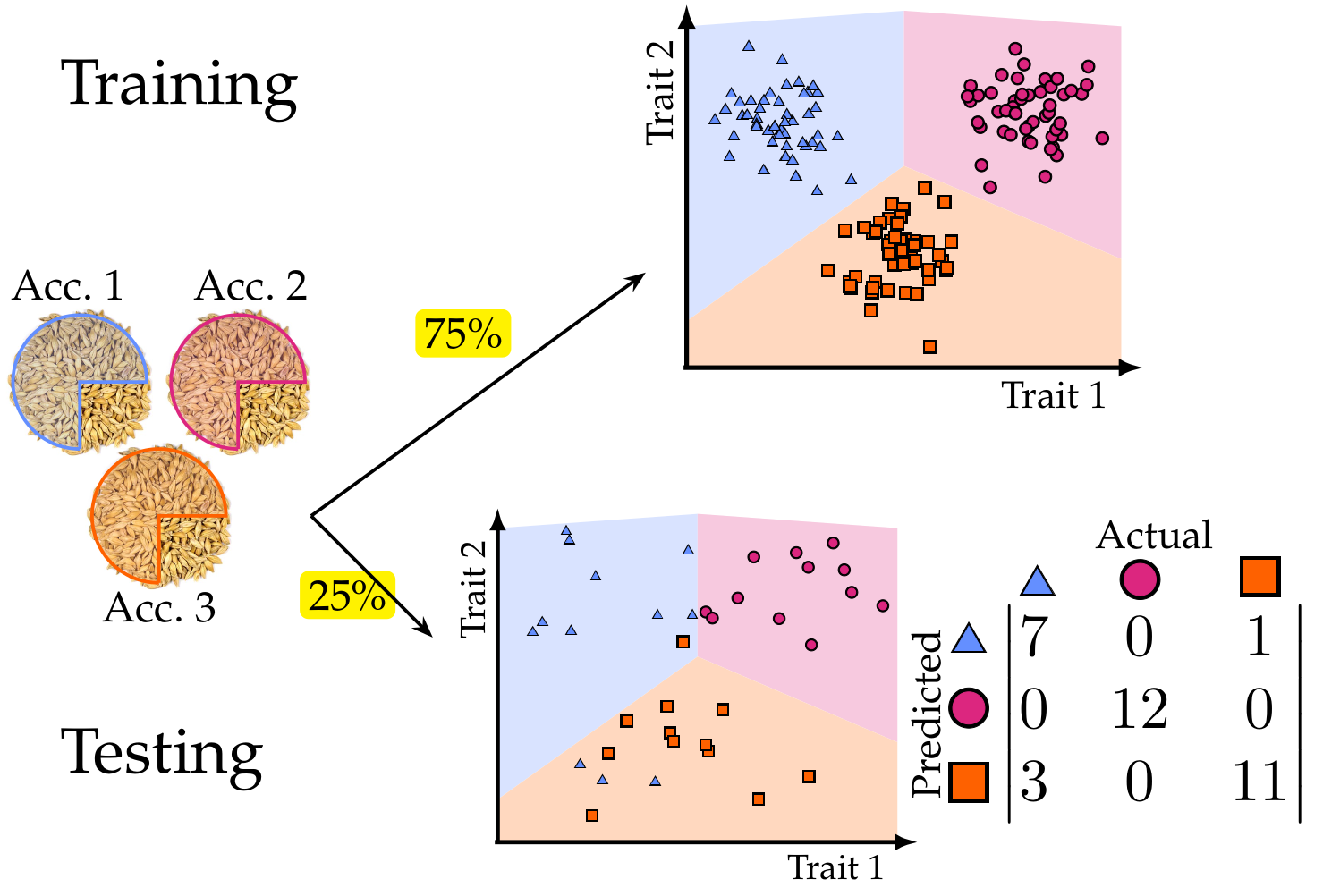 --- # Quantify the shape of barley **Goal:** Classify the **28** founding barley varieties solely by grain morphology information. <style type="text/css"> .tg {border-collapse:collapse;border-color:#93a1a1;border-spacing:0;margin:0px auto;} .tg td{background-color:#fdf6e3;border-bottom-width:1px;border-color:#93a1a1;border-style:solid;border-top-width:1px; border-width:0px;color:#002b36;font-family:Arial, sans-serif;font-size:14px;overflow:hidden;padding:10px 5px; word-break:normal;} .tg th{background-color:#657b83;border-bottom-width:1px;border-color:#93a1a1;border-style:solid;border-top-width:1px; border-width:0px;color:#fdf6e3;font-family:Arial, sans-serif;font-size:14px;font-weight:normal;overflow:hidden; padding:10px 5px;word-break:normal;} .tg .tg-2bhk{background-color:#eee8d5;border-color:inherit;text-align:left;vertical-align:top} .tg .tg-0pky{border-color:inherit;text-align:left;vertical-align:top} .tg .tg-gyvr{background-color:#eee8d5;border-color:inherit;font-size:100%;text-align:left;vertical-align:top} </style> <table class="tg"> <thead> <tr> <th class="tg-0pky">Shape descriptors</th> <th class="tg-0pky">No. of descriptors</th> <th class="tg-0pky">F1</th> </tr> </thead> <tbody> <tr> <td class="tg-2bhk">Traditional</td> <td class="tg-2bhk">11</td> <td class="tg-2bhk">0.55 ± 0.019</td> </tr> <tr> <td class="tg-0pky">Topological</td> <td class="tg-0pky">12</td> <td class="tg-0pky">0.74 ± 0.016</td> </tr> <tr> <td class="tg-2bhk">Combined</td> <td class="tg-2bhk">23</td> <td class="tg-2bhk"><strong>0.86 ± 0.010</strong></td> </tr> </tbody> </table> ### What does topology actually measure? .pull-left[ <img src="../figs/discerning_directions.png" width="225" style="display: block; margin: auto;" /> ] .pull-right[ 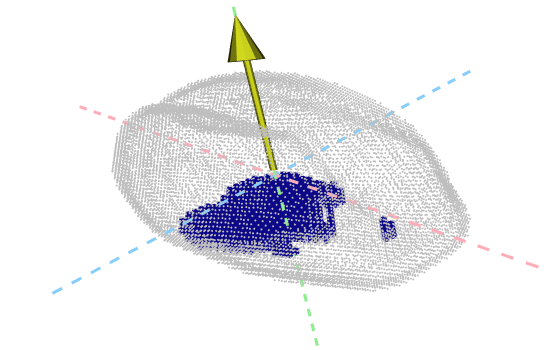 ] --- # Predicting with Semi-Supervised Learning 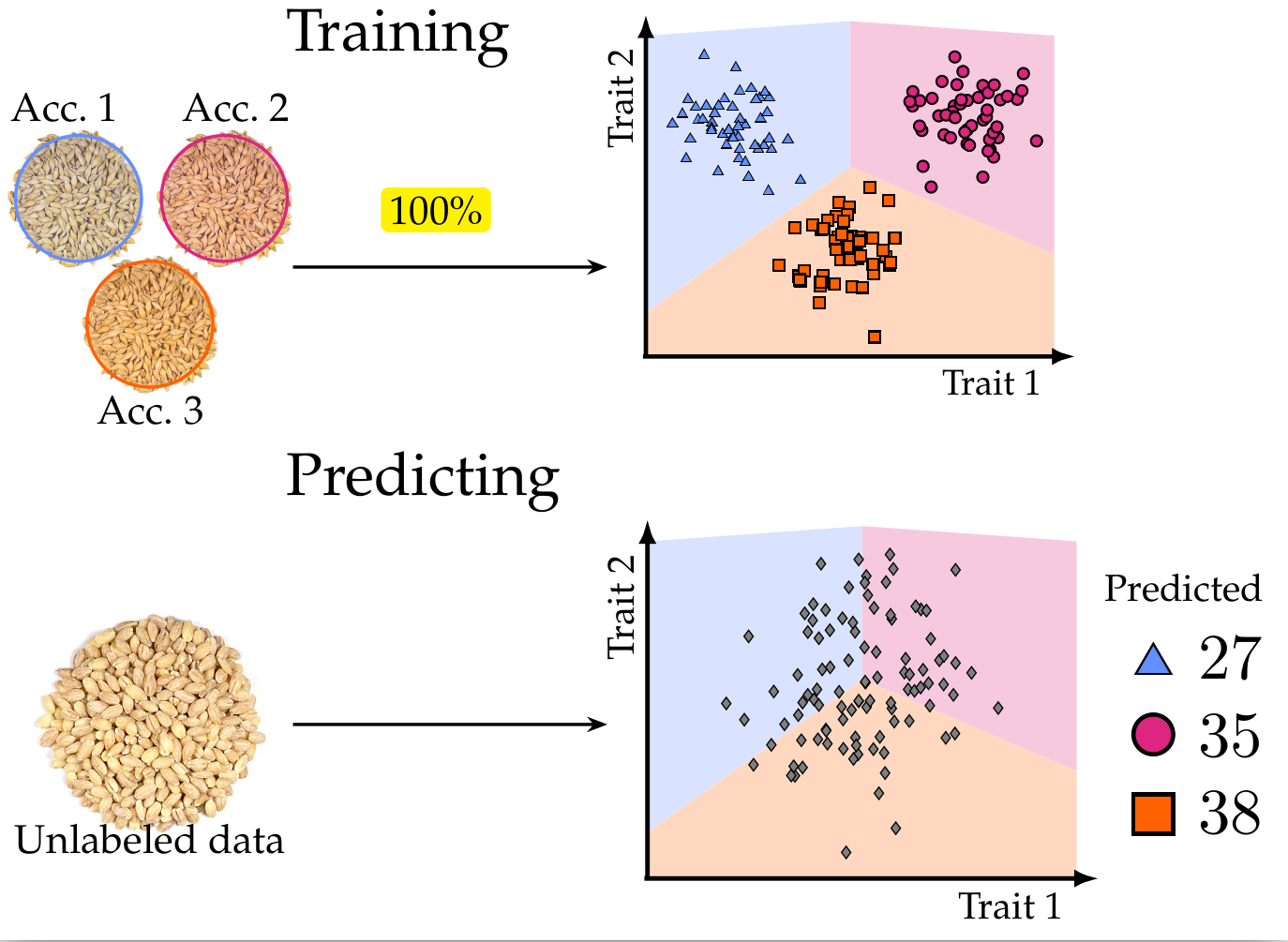 --- # Prediction into semi-supervised territory - Train an SVM with 100% of the founders `\((F_0)\)` - Classify the progeny `\((F_{18}\text{ and }F_{58})\)` to detect genotype enrichment .pull-left[  ] .pull-right[  ] --- background-image: url("../figs/comparison_lines_combined_topounscaled_d158_T16_horz.png") background-size: 900px background-position: 50% 70% ## Observe shape distribution across lines --- ## Barley scratching the surface: Future directions .left-column[ 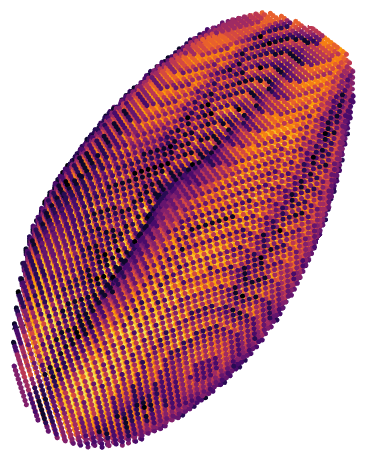 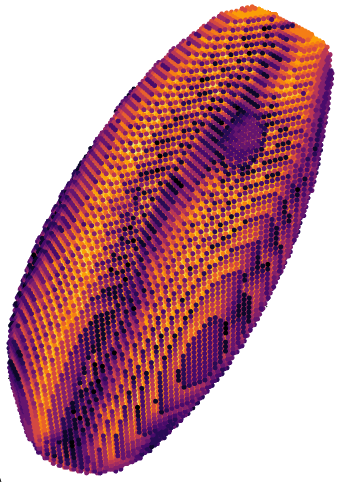 ] .right-column[ - Identify specific molecular markers corresponding to morphological differences across the diverse barley population. - Develop a high-throughput pipeline to produce 3D images of individual barley seeds and quantify comprehensively their morphology. - Formalize a method for promising seedling selection to further crop breeeding. - Extend such pipeline and population genetics studies to other crops and grains. ] --- background-image: url("https://media.istockphoto.com/id/1253437873/vector/yellow-warning-sign-work-in-progress-background.jpg?s=612x612&w=0&k=20&c=n4Mx6V6PNufYx6jTI-RzLsUHCjOLx-ypUxb5w7RKDuo=") background-size: 150px background-position: 50% 2% class: inverse, center, middle # 4. All about cracks, kernels, and domestication ## In a nutshell <img src="https://upload.wikimedia.org/wikipedia/commons/3/39/Benutzung_eines_Nussknackers.gif" width="200" style="display: block; margin: auto;" /> --- # The wal(nu)tzing nutcracker! <div class="row" style="font-family: 'Yanone Kaffeesatz'; margin: 0 auto; font-size:22px"> <div class="column" style="max-width:25%;"> <img src="../../walnuts/figs/IMGA04011.jpg"> <p style="text-align: center;">148 accessions</p> </div> <div class="column" style="max-width:42%;"> <img src="../../barley/figs/x3000_setup.jpg"> <p style="text-align: center;">1301 walnuts scanned</p> </div> <div class="column" style="max-width:33%;"> <img src="../../walnuts/figs/pat_walnut_crack_detail4.jpg"> <p style="text-align: center;">Qualitative data for crackability</p> </div> </div> <div class="row" style="font-size: 22px; font-family: 'Yanone Kaffeesatz'; margin: 0 auto;"> <div class="column" style="max-width:20%;"> <img src="../../walnuts/figs/2014SBa_R5_T81_shell_1.gif"> <p style="text-align: center; margin: 0.5ex;">Shell</p> </div> <div class="column" style="max-width:20%;"> <img src="../../walnuts/figs/2014SBa_R1_T3_001_air.gif"> <p style="text-align: center;margin: 0.5ex; ">Air</p> </div> <div class="column" style="max-width:20%;"> <img src="../../walnuts/figs/2014SBa_R1_T3_001_vein.gif"> <p style="text-align: center;margin: 0.5ex; ">Packing tissue</p> </div> <div class="column" style="max-width:20%;"> <img src="../../walnuts/figs/2014SBa_R5_T81_meat_2.gif"> <p style="text-align: center;margin: 0.5ex;">Kernel</p> </div> <div class="column" style="max-width:20%; padding: 0 0 0 5px"> <p style="margin:5px 0 0 0; text-align:left"> ▸ Individuals separated manually<br> ▸ Tissues separated with watershed segmentation<br> ▸ 38 traditional shape and size descriptors </p> </div> </div> --- ## Can you spot the Earliest Himalayan accession? <img src="../../walnuts/figs/pat_walnut_crack_crop.jpg" width="500" style="display: block; margin: auto;" /> This one accession is the most heterozygous wild type of the bunch --- ## The Earliest Himalayan accession breaks the pattern <img src="../../walnuts/figs/NewStuke_R1_T18_vs_2014SBa_R7_T26.png" width="725" style="display: block; margin: auto;" /> -- <img src="../../walnuts/figs/qual_85-023-2_scatter.jpg" width="725" style="display: block; margin: auto;" /> - The kernel of Earliest has deeper, wider cavities - Does it refer to the cavity located at the proximal end? --- class: center, inverse, middle # 5. Future directions ## Barley scratching the surface --- # Grains, oranges, and nuts oh my! .left-column[ <img src="../figs/S017_L3_1.gif" width="100" style="display: block; margin: auto;" /><img src="../../citrus/figs/SR01_L01_black_exocarp.gif" width="100" style="display: block; margin: auto;" /><img src="../../walnuts/figs/2014SBa_R5_T81_meat_2.gif" width="100" style="display: block; margin: auto;" /> ] .right-column[ - Identify specific **molecular markers** corresponding to topological traits of **barley seeds**. - Develop a high-throughput **seed phenotyping** pipeline for seed morphology. - Compute a pairwise distance matrix for citrus oil gland **distributions**. - Use **persistent homology** as an alternative to quantify the distribution of such oil glands. - Measure the size and volume of the central **cavity** of the walnut kernel. - Use the ECT or a similar approach to quantify **nuances** present in the kernel. ] --- background-image: url("../../img/phd_institutional_logos.jpg") background-size: 500px background-position: 95% 1% class: inverse ## Thank you! <div class="row" style="margin-top: -25px;"> <div class="column" style="max-width:17.5%; font-size: 13px;"> <img style="padding: 0 0 0 0;" src="https://i1.rgstatic.net/ii/profile.image/607374528233472-1521820780707_Q128/Elizabeth-Munch.jpg"> <p style="text-align: center; color: White">Liz Munch<br>(MSU)</p> <img style="padding: 0 0 0 0;" src="https://alga.win.tue.nl/images/staff/tim.jpg"> <p style="text-align: center; color: White">Tim Ophelders<br>(Utrecht)</p> <img style="padding: 0 0 0 0;" src="https://publons.com/media/thumbs/academic/photos/252a7116-ee14-4a5e-b44c-7c62ac11e217.png.200x200_q95_crop_detail_upscale.png"> <p style="text-align: center; color: White">Jacob Landis<br>(Cornell)</p> </div> <div class="column" style="max-width:17.5%; font-size: 13px;"> <img style="padding: 0 0 0 0;" src="https://www.canr.msu.edu/contentAsset/image/9ae9777d-157c-46e6-9f12-d062ad35671e/fileAsset/filter/Jpeg,Resize,Crop/jpeg_q/80/resize_w/400/crop_x/0/crop_y/45/crop_w/400/crop_h/400"> <p style="text-align: center; color: White">Dan Chitwood<br>(MSU)</p> <img style="padding: 0 0 0 0;" src="https://i1.rgstatic.net/ii/profile.image/926632407748609-1597937790454_Q128/Michelle-Quigley.jpg"> <p style="text-align: center; color: White">Michelle Quigley<br>(MSU)</p> <img style="padding: 0 0 0 0;" src="https://caes.ucdavis.edu/sites/g/files/dgvnsk1721/files/styles/sf_profile/public/images/person/pjbrown_1.jpg?h=345be249&itok=77W2Yqpk"> <p style="text-align: center; color: White">Pat Brown<br>(UC Davis)</p> </div> <div class="column" style="max-width:13%; font-size: 13px;"> <img style="padding: 0 0 0 0;" src="https://plantbiology.ucr.edu/sites/g/files/rcwecm1001/files/styles/scale_225/public/Koenig.jpg?itok=P92Ow61p"> <p style="text-align: center; color: White">Dan Koenig<br>(UC Riverside)</p> <img style="padding: 0 0 0 0;" src="https://iigb.ucr.edu/sites/g/files/rcwecm5716/files/styles/scale_225/public/Seymour.jpg?itok=pnUK_orh"> <p style="text-align: center; color: White">Danelle Seymour<br>(UC Riverside)</p> </div> <div class="column" style="width:10%; font-size: 24px;"> </div> <div class="column" style="max-width:40%; font-size: 24px; line-height:1.25"> <p style="text-align: center; color: White"><strong>Committee Members</strong></p> <p style="text-align: center; color: White; font-size: 18px;">Liz Munch<br>Dan Chitwood<br>José Perea<br>Addie Thompson</p> <p style="text-align: center; color: White"><strong>References</strong></p> <p style="color: White; font-size: 12px; text-align:left"> <strong>A</strong> <em>et al.</em> (202?) The shape of walnuts, kernels, and domestication, in a nutshell. <em>In preparation</em> </p> <p style="color: White; font-size: 12px; text-align:left"> <strong>A</strong> <em>et al.</em> (2022) The shape of aroma: measuring and modeling citrus oil gland distribution. <a href="https://doi.org/10.1002/ppp3.10333" target="_blank">DOI: 10.1002/ppp3.10333</a> </p> <p style="color: White; font-size: 12px; text-align:left"> <strong>A</strong> <em>et al.</em> (2021) Measuring hidden phenotype: Quantifying the shape of barley seeds using the Euler Characteristic Transform. <a href="https://doi.org/10.1093/insilicoplants/diab033" target="_blank">DOI: 10.1093/insilicoplants/diab033</a> </p> <p style="color: White; font-size: 12px; text-align:left"> <strong>A</strong> <em>et al.</em> (2020) The shape of things to come: Topological data analysis and biology, from molecules to organisms. <a href="https://doi.org/10.1002/dvdy.175" target="_blank">DOI: 10.1002/dvdy.175</a> </p> <p style="text-align: center; color: White; font-size:15px; line-height:1.1">Slides made in RStudio <a href="https://bookdown.org/yihui/rmarkdown/xaringan.html" target="_blank">xaringan</a>.</p> </div> </div>